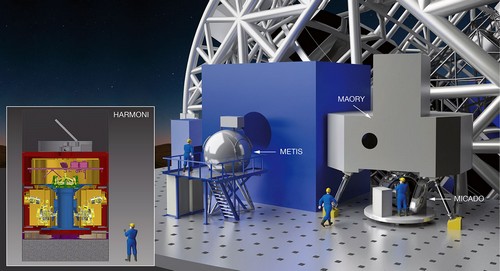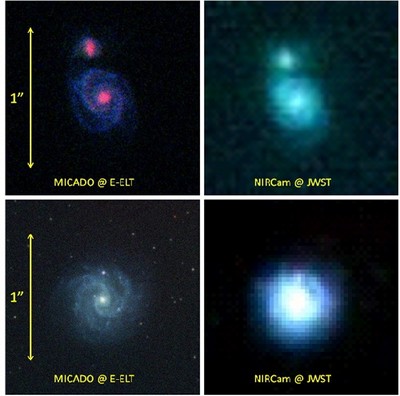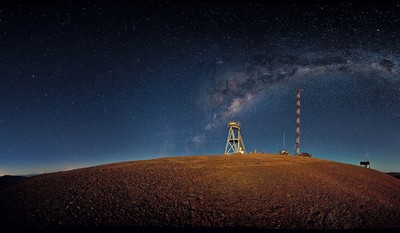Astronomers from Groningen to set the universe in motion
Astronomers from Groningen and engineers from Drenthe are collaborating to make the eyes of the new European Extremely Large Telescope (E-ELT) sharp enough to observe the motion of stars in the universe. Eline Tolstoy, Gijs Verdoes Kleijn and Ramon Navarro say they are going to set the previously motionless sky in motion.

A mirror with a diameter of 39.3 metres in a dome 80 metres in height and 100 metres in diameter. The E-ELT, which will stand in Chile, will be the largest telescope in the world when it starts operating in 2024. In recent months the contracts have been signed for the delivery of the first three instruments that will process the light from the enormous mirror. MICADO (Multi-AO Imaging Camera for Deep Observations) is one of these, and Groningen and Drenthe will play an important role in its development.
As ‘Project Scientist Europe’, Professor Eline Tolstoy from the University of Groningen is responsible for MICADO’s scientific programme. Astronomer Gijs Verdoes Kleijn says, ‘We at the University of Groningen’s Kapteyn Astronomical Institute will build a “software pipeline” to process the data that MICADO produces’. This part of the project is his responsibility. Furthermore, the Optical/IR Lab of NOVA, the national research school for astronomy, which is located at ASTRON in Dwingeloo, will build a piece of hardware for MICADO.
This joint effort will take 53 person-years, but it will be well worth it. ‘We get 65 observation nights in return, which we and our international science team can use however we like’, Tolstoy explains. Observation time is like gold in astronomy: if you do not help build a telescope, you need to compete with the whole astronomy world to secure your hours.

As the name suggests, the E-ELT will be extremely large, but what is so special about that? Verdoes Kleijn explains, ‘It is what we call a photon collector. The mirror collects a huge amount of light. And the ability to generate separate images of two objects that are very close together, the resolution, is much greater in the E-ELT than in other telescopes.’
This will make it possible to see separate stars not just in the centre of our Milky Way but in other galaxies too. The E-ELT will also make it possible to determine the position of stars so precisely that it will be possible to measure their motion through the universe. ‘That is not currently possible with stars that are far away’, says Verdoes Kleijn. He adds, with a big smile, ‘It may sound strange, but we are going to defrost a sky that was frozen. Stars are now fixed anchor points, but MICADO will make them twinkle. That will be a magnificent moment for us.’
If you measure the motion of stars, you can determine the local matter, both the normal visible matter and the invisible dark matter. That in turn says reams about how stars, black holes and galaxies develop. However, MICADO will do more than just determine positions: it will contain a camera that is sensitive enough to discover exoplanets, and possibly even study them. It will also contain a spectrometer that can measure the exact wavelengths at which stars emit light.
Verdoes Kleijn heads up the Groningen group that is developing the software that will analyse the data from MICADO. ‘Various things are already available for spectral analysis. It is the imaging that is new. We want to know where exactly in a pixel the photon hit, for instance’. The statistical analysis of a series of observations will make this possible.
The E-ELT uses Adaptive Optics, a method used to correct for atmospheric turbulence. A laser beam is projected alongside the stars that the telescope is to observe. ‘This can be used as a guide star to measure possible distortion’. Deformable mirrors compensate for and thus remove the distortion.
Alongside this first correction, MICADO itself will contain a further correction mechanism, the Atmospheric Dispersion Corrector. This will correct for the refraction of light in the atmosphere. This crucial part will be built in Dwingeloo, in a team lead by Ramon Navarro from NOVA, the national research school for astronomy.

‘It is ideal that the correction mechanism and the software are being built just round the corner from each other’, say Navarro and Verdoes Kleijn. ‘The hardware and software both play a role in achieving optimum image quality, so it is very useful to be so close by.’ Not to mention that the Scientific Director for the instrument is just along the corridor in the Kapteyn Institute.
‘We are constantly developing our expertise’, is the message of the three MICADO project leaders from the northern Netherlands. They bring to MICADO their prior experience of developing the software and hardware for other instruments, such as OmegaCAM and Xshooter. ‘With the unbelievable advance in precision that we will see in MICADO we will gain new knowledge that we will also be able to use after 2024.’
The E-ELT will have a higher resolution than the Hubble Space Telescope and its successor, the James Webb Space Telescope , and astronomers from the University of Groningen will be among the first to benefit from this. Incidentally, their colleagues from Leiden University are working on a second instrument, Metis, which will provide infrared imaging and spectroscopy. It just goes to show that astronomy is flourishing in the Netherlands.
| Last modified: | 26 April 2019 1.25 p.m. |
More news
-
16 April 2024
UG signs Barcelona Declaration on Open Research Information
In a significant stride toward advancing responsible research assessment and open science, the University of Groningen has officially signed the Barcelona Declaration on Open Research Information.
-
02 April 2024
Flying on wood dust
Every two weeks, UG Makers puts the spotlight on a researcher who has created something tangible, ranging from homemade measuring equipment for academic research to small or larger products that can change our daily lives. That is how UG...
-
18 March 2024
VentureLab North helps researchers to develop succesful startups
It has happened to many researchers. While working, you suddenly ask yourself: would this not be incredibly useful for people outside of my own research discipline? There are many ways to share the results of your research. For example, think of a...

